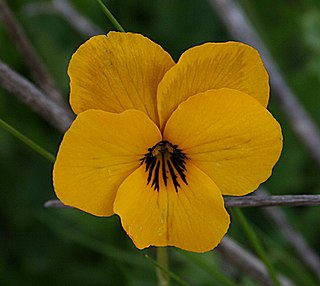
Viola pedunculata, the California golden violet, Johnny jump up, or yellow pansy, is a perennial yellow wildflower of the coast and coastal ranges in California and northwestern Baja California. The common name "Johnny jump up" is usually associated with Viola tricolor however, the introduced garden annual.
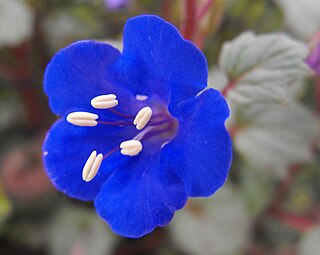
Phacelia campanularia is a species of flowering plant in the borage family, Boraginaceae, known by the common names desertbells, desert bluebells, California-bluebell, desert scorpionweed, and desert Canterbury bells. Its true native range is within the borders of California, in the Mojave and Sonoran Deserts, but it is commonly cultivated as an ornamental plant and it can be found growing elsewhere as an introduced species.

Viola beckwithii, known commonly as the Great Basin violet, Beckwith's violet, and sagebrush pansy, is a species of violet native to the western United States. It is an early-flowering plant of sagebrush habitats in the Great Basin region.
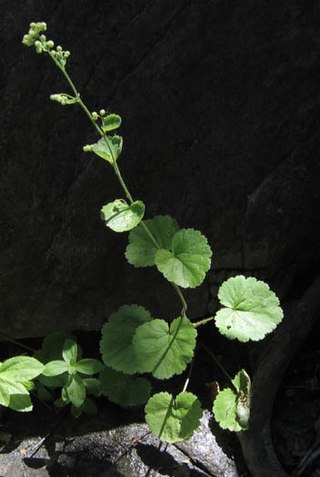
Boykinia rotundifolia is an uncommon species of flowering plant in the saxifrage family known by the common name roundleafed brookfoam. It is endemic to Southern California, where it grows in shady forested areas near streams in the mountains.

Castilleja subinclusa is a species of Indian paintbrush known by the common names longleaf Indian paintbrush and Franciscan paint brush.
Clarkia borealis is a rare species of flowering plant in the evening primrose family known by the common name northern clarkia. It is endemic to California, where it is known from the forests of the southern Klamath Range and the southernmost Cascade Range foothills. It is an annual herb growing an erect, slender stem. The leaves are oval in shape and borne on short petioles. The top of the stem is occupied by the inflorescence, in which the lowest flowers open first and hanging, pointed flower buds occur at nodes at the top. The sepals separate as the flower blooms, revealing purplish pink petals. Each petal is between 1 and two centimeters long, elongated triangular to semicircular in shape, and sometimes flecked with dark purple. There are 8 stamens with anthers bearing blue-gray pollen, and a protruding stigma.
Streptanthus morrisonii is an uncommon species of flowering plant in the mustard family known by the common name Morrison's jewelflower. It is endemic to California, where it is known from the North and Central Coast Ranges. It is limited to serpentine soils in chaparral and forest habitat. It is considered a species complex which includes Streptanthus brachiatus. S. morrisonii is divided into four subspecies and is variable. In general, it is a biennial herb producing a hairless, waxy stem up to 1.2 to 1.5 meters in maximum height, often branching at the tip. The basal leaves have fleshy, lance-shaped blades 3 to 5 centimeters long borne on petioles. The blades are gray-green on the upper surface and purple or purple-mottled underneath. Leaves higher on the stem are variable in shape and become smaller toward the top of the plant. Flowers occur at intervals along the upper stem. Each has an urn-shaped calyx of keeled sepals in shades of yellow-green to purple. The petals emerging from the tip are whitish with purple-brown veining. The fruit is a flattened straight or slightly curved silique up to 8 centimeters long.
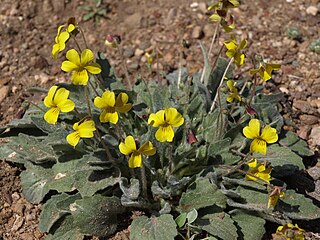
Viola purpurea var. aurea, also known as golden violet and bright yellow violet, is a variety of violet. It is endemic to the western United States, where it is known from scattered occurrences in various types of dry habitat such as the slopes of desert mountains.

Viola bakeri is a species of violet known by the common name Baker's violet. It is native to the Western United States, from Washington and Oregon, to the mountains of northern Nevada, and in California to the southern High Sierra Nevada.

Viola cuneata is a species of violet known by the common name wedge-leaf violet. It is native to southwestern Oregon and northwestern California, where it occurs in the forests of the coastal mountain ranges, often on serpentine soils.

Viola douglasii is a species of violet known by the common name Douglas' violet, or Douglas' golden violet. It is native to western North America from Oregon through California and into Baja California, where it grows in seasonally moist habitat, often on serpentine soils. This rhizomatous herb produces a cluster of erect stems just a few centimeters in length to about 20 centimeters in maximum height. The leaf blades are deeply dissected into several narrow lobes or compound, made up of leaflets, and borne on long petioles. They are hairless to softly hairy in texture. A solitary flower is borne on a long, upright stem. It has five bright or deep yellow petals with brown veining and brown outer surfaces. The largest lowest petal may be over 2 centimeters in length.
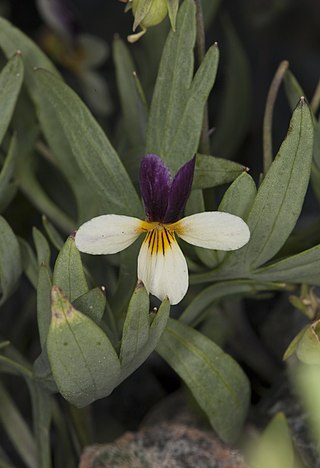
Viola hallii is a species of violet known by the common names Oregon violet and Hall's violet. It is native to southwestern Oregon and northwestern California, where it occurs in open areas in the forests and chaparral of the coastal mountain ranges, on gravelly soils, often of serpentine origin.

Viola ocellata is a species of violet known by the common names pinto violet, two-eyed violet, and western heart's ease. It is native to southern Oregon and northern and central California, where it occurs in the coastal foothills and mountain ranges. It sometimes grows in serpentine soils and in quicksilver mines.
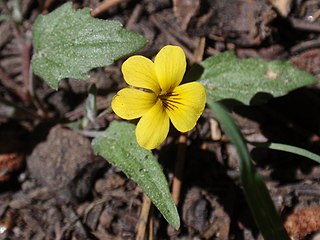
Viola pinetorum is a species of violet known by the common names goosefoot violet, goosefoot yellow violet, gray-leaved violet, or mountain yellow violet. It is endemic to California, where it grows in mountain ranges throughout the state. It occurs in various types of mountain habitat, including forests and talus. This herb grows from a tough taproot and produces an erect or decumbent stem up to about 22 centimeters long. The leaves are linear to oval in shape with pointed tips and toothed edges. The longest ones reach 15 to 20 centimeters in length. A solitary flower is borne on a long, upright stem. It has five yellow petals, the lowest three veined with brownish purple, and the upper two with brownish purple coloring on the outer surfaces.

Viola praemorsa is a species of violet known by the common names canary violet, Astoria violet, yellow montane violet, and upland yellow violet.

Viola sheltonii is a species of violet known by the common names Shelton's violet and fan violet. It is native to the western United States where it occurs in forests, woodlands, and chaparral habitat. This rhizomatous herb produces a cluster of stems up to about 27 centimeters tall. The fan-like leaf blades are each divided into leaflets which are deeply dissected into narrow segments, the whole blade borne on a long petiole. A solitary flower is borne on a long, upright stem. It has five yellow petals, the lower three veined with purple-brown and the upper two stained purple-brown on the outer surfaces.
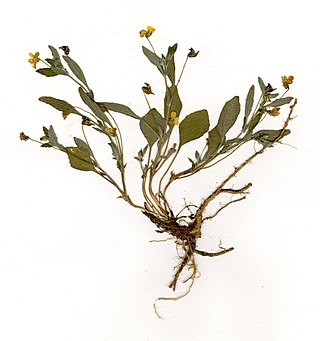
Viola tomentosa is a species of violet known by the common names feltleaf violet and woolly violet. It is endemic to the central Sierra Nevada of California, where it occurs in various types of dry mountain forest habitat. This small herb grows from a deep taproot, reaching a maximum height of 5 to 10 centimeters. The herbage is coated with woolly hairs. The leaves have oval blades borne on petioles a few centimeters long. A solitary flower is borne on a short upright stem. It is under a centimeter long with five yellow petals. The lower three petals are veined with dark brown and the upper two are stained brown or purplish on the back sides.

Viola chamissoniana is a species of flowering plant in the violet family known by the common name 'olopu. It is endemic to Hawaii, where it is known from the islands of Kauai, Oahu, Molokai, and Maui.
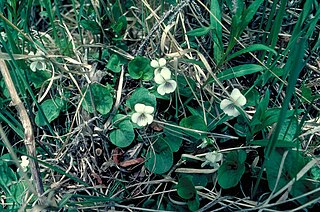
Viola renifolia is a species of violet known by the common names white violet and kidneyleaf violet. It is native to northern North America, where it has a widespread distribution across Canada and the northern United States as far south as Washington, Colorado, and New York.
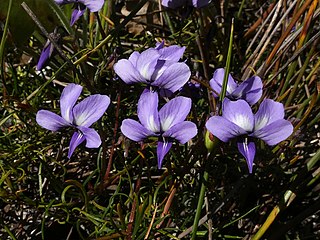
Viola decumbens is a perennial plant with a woody base that is assigned to the violet family. It has linear leaves and stipules. The bilaterally symmetrical purple flowers have five petals and a spur. It grows in fynbos and is an endemic species of the southern Western Cape province of South Africa, where it is called wild violet, a name used for other species elsewhere in the world.



















